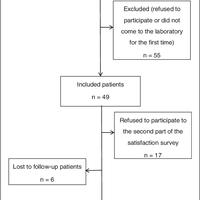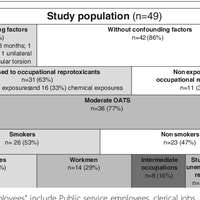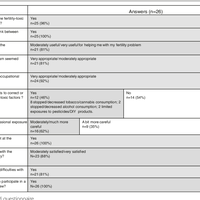Abstract
Background: Male infertility related to professional reprotoxic exposure has been assessed in several studies. Collaboration between occupational physicians and patients can yield information about the preventive measures that can be taken to avoid such exposure. The use of preventive measures is determined by the collaboration between reproductive medicine and occupational medicine and also by the patient's awareness of reprotoxic occupational exposures. Our andrology laboratory developed a systematic environmental interview that an occupational physician administers before semen analysis to assess patients' occupational reprotoxic chemical and physical exposures. This observational prospective study evaluated patients' feelings regarding this interview. The main outcome measure was the participants' score to determine their general reprotoxicant knowledge. The study also evaluated the patients' satisfaction about the interview with occupational physician and their attitude about reproductive toxicants. Results: The mean score for general knowledge of reprotoxicants was 9.6 ± 2.7/16. The most frequently underestimated reprotoxic factor was excessive heat (34.7 % correct responses). In cases of semen parameter abnormalities AND recognized occupational reprotoxic exposure, 63.2 % of the patients said they would use individual protective devices, and 55.1 % said they would temporarily adapt their workstation. Regarding the interview with the laboratory's occupational physician, 80.7 % considered it moderately or very useful. Of the interviewed patients, 46.2 % reported having changed their living habits 2 months after the interview, and 88.5 % were satisfied or very satisfied with the care they received. All of the respondents said it would be useful to extend the interview to include their wives. Conclusions: The data suggest that patients' knowledge about reprotoxic exposures can be improved, particularly knowledge related to physical exposure. The vast majority of patients were satisfied with the introduction of this new collaboration between reproductive and occupational medicine.
Figures
Author supplied keywords
Register to see more suggestions
Mendeley helps you to discover research relevant for your work.
Cite
CITATION STYLE
Christiaens, A., Sari-Minodier, I., Tardieu, S., Ianos, O., Adnot, S., Courbiere, B., & Perrin, J. (2016). A pilot study about infertile men’s awareness of their reprotoxic exposures and the intervention of occupational medicine to assess them. Basic and Clinical Andrology, 26(1). https://doi.org/10.1186/s12610-016-0036-5






